
Daniel Chester French was an American sculptor in the late 19th and early 20th centuries. His works include the The Minute Man, an 1874 statue in Concord, Massachusetts, and his 1920 monumental statue of Abraham Lincoln at the Lincoln Memorial in Washington, D.C.

Edward Clark Potter was an American sculptor best known for his equestrian and animal statues. His most famous works are the marble lions, nicknamed Patience and Fortitude, in front of the New York Public Library Main Branch
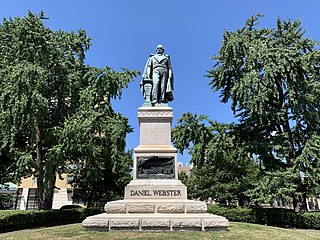
The Daniel Webster Memorial is a monument in Washington, D.C., honoring U.S. statesman and lawyer Daniel Webster. It is located near Webster's former house, beside Scott Circle, at the intersection of Massachusetts Avenue, N Street, and Rhode Island Avenue NW. The person who commissioned the memorial was Stilson Hutchins, founder of The Washington Post, who greatly admired Webster. Congress approved the memorial in 1898 and the dedication ceremony took place in January 1900. Amongst the attendees at the ceremony were President William McKinley and his cabinet, members of Congress, and Supreme Court justices.

Major General John A. Logan, also known as the General John A. Logan Monument and Logan Circle Monument, is an equestrian statue in Washington, D.C., that honors politician and Civil War general John A. Logan. The monument is sited in the center of Logan Circle, a traffic circle and public park in the Logan Circle neighborhood. The statue was sculpted by artist Franklin Simmons, whose other prominent works include the Peace Monument and statues in the National Statuary Hall Collection. The architect of the statue base was Richard Morris Hunt, designer of prominent buildings including the Metropolitan Museum of Art in New York City and The Breakers in Newport, Rhode Island. Prominent attendees at the dedication ceremony in 1901 included President William McKinley, members of his cabinet, Senator Chauncey Depew, Senator Shelby Moore Cullom, and General Grenville M. Dodge.
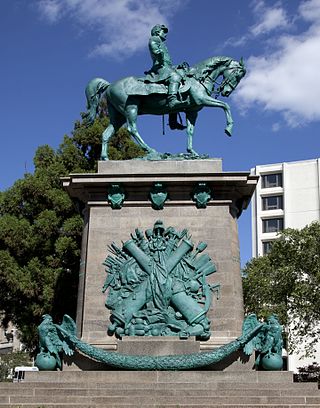
Major General George B. McClellan is an equestrian statue in Washington, D.C. that honors politician and Civil War general George B. McClellan. The monument is sited on a prominent location in the Kalorama Triangle neighborhood due to efforts made by area residents. The statue was sculpted by American artist Frederick William MacMonnies, a graduate of the École des Beaux-Arts whose best known work is a statue of Nathan Hale in New York City. MacMonnies was chosen to design the statue following a lengthy competition organized by a statue commission, led by then Secretary of War William Howard Taft. The monument was dedicated in 1907, with prominent attendees at the ceremony including President Theodore Roosevelt, New York City mayor George B. McClellan Jr., politicians, generals and thousands of military personnel.

Major General George Henry Thomas, also known as the Thomas Circle Monument, is an equestrian sculpture in Washington, D.C. that honors Civil War general George Henry Thomas. The monument is located in the center of Thomas Circle, on the border of the downtown and Logan Circle neighborhoods. It was sculpted by John Quincy Adams Ward, best known for his work on the statue of George Washington in Wall Street, Manhattan. Attendees at the dedication in 1879 included President Rutherford B. Hayes, Generals Irvin McDowell, Philip Sheridan, and William Tecumseh Sherman, senators and thousands of soldiers.

The Dupont Circle Fountain, formally known as the Rear Admiral Samuel Francis Dupont Memorial Fountain, is a fountain located in the center of Dupont Circle in Washington, D.C. It honors Rear Admiral Samuel Francis Du Pont, a prominent American naval officer and member of the Du Pont family. The fountain replaced a statue of Du Pont that was installed in 1884. Designed by Henry Bacon and sculpted by Daniel Chester French, the fountain was dedicated in 1921. Prominent guests at the dedication ceremony included First Lady Florence Harding, Secretary of War John W. Weeks and Secretary of the Navy Edwin Denby.

The Soldiers' National Monument is a Gettysburg Battlefield memorial which is located at the central point of Gettysburg National Cemetery. It honors the battle's soldiers and tells an allegory of "peace and plenty under freedom … following a heroic struggle." In addition to an inscription with the last 4 lines of the Gettysburg Address, the shaft with 4 buttresses has 5 statues:
A large statue representing the concept of Liberty surmounts the pedestal. Eighteen large bronze stars circling the pedestal below this statue represent the eighteen Union states with buried dead. A statue is located at each corner near the base. They represent War, History, Peace, and Plenty. War is represented by a statue of an American soldier who recounts the story of the battle to History. In turn, History records, with stylus and tablet, the achievements of the battle and the names of the honored dead. A statue of an American mechanic and his tools illustrates Peace. Plenty is a female figure with a sheaf of wheat and the fruits of the earth that typify peace and abundance as the soldier's crowning triumph.

Abraham Lincoln is a marble sculpture of U.S. President Abraham Lincoln by Irish artist Lot Flannery, located in front of the old District of Columbia City Hall in Washington, D.C., United States. The statue is the nation's oldest extant memorial to the president and was installed several blocks from Ford's Theatre, where Lincoln was assassinated. Flannery was present at the theater on the night of Lincoln's assassination.

An equestrian statue of Joseph Hooker is installed outside the Massachusetts State House, facing Beacon Street in Boston, in the United States.

The Minute Man is an 1874 sculpture by Daniel Chester French in Minute Man National Historical Park, Concord, Massachusetts. It was created between 1871 and 1874 after extensive research, and was originally intended to be made of stone. The medium was switched to bronze and it was cast from ten Civil War-era cannons appropriated by Congress.
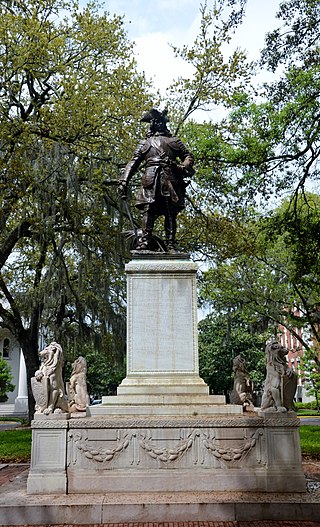
The James Oglethorpe Monument is a public monument in Chippewa Square, Savannah, Georgia, United States. It honors James Oglethorpe, the founder of the Province of Georgia, who established the city of Savannah in 1733. Efforts to erect the monument began in 1901 and were led by members of several patriotic groups in the city. They were key in securing the necessary U.S. government funds for the monument, which consists of a bronze statue of Oglethorpe designed by Daniel Chester French, atop a large granite pedestal designed by Henry Bacon. It was dedicated in 1910, in a ceremony that attracted several thousand spectators and was attended by several notable government officials.

The equestrian statue of Charles Devens is a public monument in Worcester, Massachusetts, United States. Located in front of the old Worcester County Courthouse in the Institutional District, the equestrian statue honors Charles Devens, who served as a general in the Union Army during the American Civil War and later served as United States Attorney General. The statue was designed by Daniel Chester French and Edward Clark Potter and was dedicated on July 4, 1906.

The George Frisbie Hoar statue is a public monument in Worcester, Massachusetts, United States. Located on the north side of the Worcester City Hall, the monument honors George Frisbie Hoar, a politician from the city. The monument, which consists of a statue designed by Daniel Chester French, was dedicated in 1908.
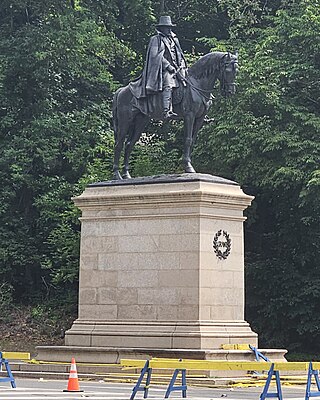
The equestrian statue of Ulysses S. Grant is a public monument in Philadelphia, Pennsylvania, United States. Located in Fairmount Park, the monument honors Ulysses S. Grant, who served as a general in the Union Army during the American Civil War and later as President of the United States. The monument was designed by Daniel Chester French and Edward Clark Potter and consists of an equestrian statue atop a pedestal. The statue was dedicated in 1899.

Marquis de Lafayette is a monumental statue on the campus of Lafayette College in Easton, Pennsylvania. The statue, designed by Daniel Chester French and standing on a pedestal designed by Henry Bacon, was dedicated in 1921 in honor of the college's namesake, Gilbert du Motier, Marquis de Lafayette. The statue is located at the south entrance of Colton Chapel. It is one of a number of sculptures made by French for universities, which includes the statue of John Harvard at Harvard University and Alma Mater at Columbia University.

Commodore George Hamilton Perkins is a public memorial that stands on the grounds of the New Hampshire State House in Concord, New Hampshire, United States. The statue was designed by sculptor Daniel Chester French, with architect Henry Bacon designing the remainder of the public monument. It honors George H. Perkins, a New Hampshire native who had served as an officer in the United States Navy during the American Civil War. The statue was dedicated in 1902.

Thomas Brackett Reed is a monumental statue located on the Western Promenade in Portland, Maine, United States. Dedicated in 1910, the statue was designed by sculptor Burr Churchill Miller and honors Thomas Brackett Reed, a politician from Maine who served for several years as the speaker of the United States House of Representatives.

The Israel Putnam Monument is an equestrian statue located in Brooklyn, Connecticut, United States. The monument, designed by sculptor Karl Gerhardt, was dedicated in 1888 in honor of Israel Putnam, a Connecticut native who served as a general in the Continental Army during the American Revolutionary War. The monument was created as a response to the deteriorated condition of Putnam's grave in Brooklyn's cemetery, and the state government allocated funds for the monument with the provision that it also serve as a tomb for Putnam. Upon its completion, Putnam's remains were reinterred under the monument. The dedication was held on June 14 in a large ceremony with several guests of honor, including the governors of Connecticut and Rhode Island. The monument was criticized by contemporary reviewers, who especially criticized the horse, with one review noting that it appeared to be suffering from bone spavin.
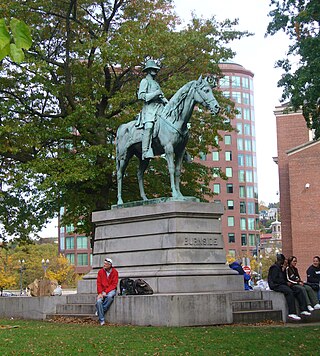
Major General Ambrose E. Burnside, also known as the Ambrose Burnside Monument, is a monumental equestrian statue in Providence, Rhode Island, United States. The statue, located in the city's Burnside Park, was designed by sculptor Launt Thompson and depicts Ambrose Burnside, an officer in the Union Army during the American Civil War who later served as the governor of Rhode Island. Ambrose had died in 1881 and the project to erect a statue in his honor began shortly afterwards. It was dedicated on July 4, 1887 in a large ceremony that included several notable guests of honor, such as General William Tecumseh Sherman, Colonel Robert Hale Ives Goddard, and the governors of both Connecticut and Rhode Island. The monument was originally located in Exchange Place, but it was moved to its current location in the early 1900s. As part of the move, the pedestal was replaced with one designed by William R. Walker.




















